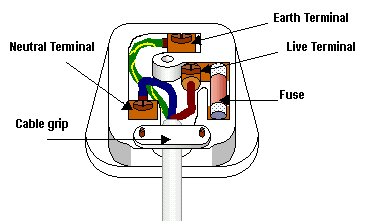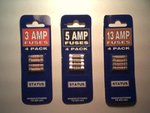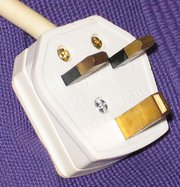BS 1363
|
|
G_plug.png
BS 1363 (British Standard) is the standard that defines what is colloquially called the 13 amp plug, which is the most common type of mains power plug in the British Isles. Other plug types such as IEC 309 and BS 546 are only seen in old installations and specialised applications where either the BS 1363 plug is unsuitable or where mateability with the standard variety is not desired.
See also the entry in the mains power plug article on the British three-pin plug.
A BS 1363 plug has two horizontal, rectangular pins for live and neutral, and above these pins, a larger, vertical pin for an earth connection. Unlike many other plugs, the earth pin is mandatory as it is needed to open the shutters. It also polarises the plug. Moulded plugs for unearthed, double-insulated appliances can substitute this contact with a plastic pin.
These plugs are required to carry a cartridge fuse, manufactured to BS 1362, which can be rated at 3, 5, 10 or 13 amperes. The maximum load that can be placed on a socket, including double and triple sockets, is 13 A. The double sockets are unfused, so it is possible to draw up to 26 A before hitting the rated current of any overcurrent protection. However when drawing up the standard it was decided to require double sockets to be able to take only 13 A in total!. Most sockets can stand more than this, at least for a short while, but continuous running at 26 A will result in a damaged socket. Surprisingly, however, this has not posed a problem in practice, probably because very few domestic appliances draw the full 13 A for any significant time. Triple and larger sockets are fitted with a 13 A fuse of the same type used in the plugs.
The plugs and sockets are designed to carry up to 250 volts AC, 50 hertz.
For information on the safe installation of BS 1363 sockets, see the article on Electrical wiring (UK).
This plug is often described as the safest in the world and to many outsiders it often seems excessively safety conscious and somewhat cumbersome. The high extraction force can be inconvenient, particularly for people with weak hands, such as the elderly. To counter this, plugs with handles, and straps to provide existing plugs with a handle, have been produced but have not been popular. The large size can make the plugs inconvenient when there are many plugs in a small space, as on power strips.
| Contents |
Safety measures
Fusing
All plugs with the exception of a few power supply units are fused. This is in addition to the fuses or circuit breakers in consumer units/distribution boards.
Prior to the introduction of the 13 amp plug the BS546 2A 5A and 15A plugs were used. With this system the only fuses were in the consumer unit. 15A sockets were generally given a dedicated 15A circuit. 5A sockets might be on a 15A circuit with multiple sockets or on a dedicated 5A circuit. 2A sockets were generally connected to the lighting circuit which was fused at 5A. Adaptors were available from 15A down to 5A and from 5A down to 2A so in practice it was quite possible for an appliance with the smallest size of flex to be protected only by a 15A fuse.
When the practice of using 30A ring circuits was introduced to save copper whilst also allowing more flexibility it was considered unsafe to allow appliance flexes to be connected to such a high rated circuit with no further protection. Due to this the plug/socket combination had to provide the fuse. It was decided to place the fuse in the plug and in order to make sure people only used fused plugs to connect to the new circuits a new plug type was required: the BS 1363 13A plug.
Putting the fuse in the plug also allows a range of ratings to be fitted providing superior protection for smaller flexes. This is especially useful for long small flexes or for extention leads that are not rated at the full 13A. Fuses for fittings to BS 1363 must conform to BS 1362. This specification describes a sand-filled ceramic bodied fuse, 1" (25.4 mm) in length and 1/4" (6.35 mm) in diameter.
- 3 A fuses (colour-coded red) are intended mainly for small load (750 W max.) appliances such as radios and desk lamps.
- 5 A fuses (black, but so are other less common ratings) are for medium load (1250 W max.) appliances such as desktop computers and TV sets.
- 13 A fuses (colour-coded brown) are for heavy load (3250 W max.) appliances such as irons and electrical heaters.
- Ratings of 1, 2, 7 and 10 amperes are available and are all coloured black, but are rare (1 A is extremely rare).
The fuses are mechanically compatible, but inserting a fuse too weak for the appliance will likely cause the fuse to blow prematurely while using too strong a fuse will degrade safety as the fuse will blow less quickly or in extreme cases not at all in the event of a fault. Having said that, most other systems do not bother with using smaller fuses to protect the smaller flex sizes and it doesn't seem to be a problem in practice.
Rewirable BS 1363 plugs are always sold fitted with a fuse, usually 13A. This fuse must be changed if fitting the plug to an appliance which requires a fuse with a smaller rating. Plugs with smaller fuse sizes already fitted are sold but are not as common. As a result, before factory-fitted plugs became the norm it was common to have a lot of spare 13A fuses around that had been removed from newly purchased plugs.
Shuttering
British power outlets incorporate shutters on the live and neutral contacts to prevent someone from pushing a foreign object into the socket. On most sockets these are opened by the earth pin which is longer than the others and must always be present (though on Class 2 (double insulated) equipment with moulded-on plugs or euro converter plugs (see later) and on class 2 power supply units it may be plastic). A notable exception to this method of opening shutters are sockets made by MK. These use a proprietary system which seems to depend on the shape of the live and neutral pins and does not depend on the earth pin. Some older sockets simply require equal pressure to be placed upon the live and neutral shutters (towards the outer edges so as to stop insertion of 4-mm plugs). On sockets which use the earth pin to open the shutters, said shutters can be opened by inserting an object into the Earth hole (a screwdriver works well for this). Electricians do this frequently to allow them to insert test probes into sockets. The 4-mm pin European plug types (CEE 7/16, Gost 7396) will fit in after doing this, and 4.8-mm ones (CEE 7/4, 7/7 or 7/17) will go in if forced. However the lack of earth connection (if the plug has it) and the fact that BS 1363 sockets will often only be protected by a 30 A or 32 A fuse or breaker (which is much higher than the wiring regulations permit for other non industrial socket types) means this is not recommended.
Pin insulation
The live and neutral pins have insulated bases to prevent finger contact with pins and also to stop metal sheets (for example, fallen blind slats) from becoming live if lodged between the wall and a partly pulled out plug. A downside to this prong insulation is that it may contribute to damaged sockets not making good contact with the prongs, which may even melt the latter. No such problems exist with healthy sockets.
Others
- The plug is polarised, so it should always be clear which lead or prong is live.
- Wall sockets usually incorporate switches to turn off the power. Some interpret the regs as requiring an adjacent switch where this is not incorporated into the socket, however this interpretation is not widely agreed on by electricians.
- The cable always enters the plug from the bottom, thus making it difficult for people to unplug the (quite firmly fitting) plug by tugging on the cable. (This practice — possible with many other plug designs — can be hazardous as it can damage the cable insulation causing shorts or tear the conductors, leading to overheating or even internal arcing across the resulting break in the conductor.) On the other hand this tight fitting and bottom entry of cable means that the stresses on the cable when it is pulled hard (by for example tripping over it) are even higher.
- The plug is firmly fitting and therefore difficult to dislodge by accidental knocks or strains on the cord
- The design of the earth pin ensures that the earth path is connected before the live, and remains connected after the live is removed.
- Should the cable be tugged from the plug, the designed lengths of the internal wires should mean that the live wire is disconnected first, followed by the neutral and finally the earth. This ensures that an abused plug will fail safely.
Euro converter plugs
Some manufacturers/distributers use a special type of plug for conversion of Class 2 appliances from mainland Europe which are fitted with moulded europlugs. Unlike a travel adaptor these plugs when closed look fairly similar to normal plugs. Inside are two metal clips into which the metal ends of the europlugs pins are clipped. The body of the converter plug is shaped to grip the europlug. The hinged lid is then shut to cover the connections to the europlug and is screwed shut. These plugs have a plastic earth pin and a fuse accessible from the outside and in some cases are fitted with screws that are made to be difficult to unscrew.
Countries of use
This design is in use not only in the United Kingdom, but also in Ireland, Cyprus, Botswana, Ghana, Malta, Hong Kong, Macao, Malaysia, Oman, Singapore, Kenya, Iraq, and Qatar.
In the Republic of Ireland the National Standards Authority of Ireland (NSAI) issued the Irish Standard I.S. 401 Safety Requirements for Rewireable 13A Fused Plugs for Normal and Rough Use Having Insulating Sleeves on Line and Neutral Pins which is largely similar to BS 1363. Any relevant plugs originating or sold, in the Republic, must pass the Irish Standard or an equivalent standard of a member of European Union, which includes BS 1363.
The UK, and some of these other countries, also use the older BS 546 round-pin socket standard.
In some continental European countries (e.g., Germany), the BS 1363 system is today often used for low-voltage (12 V or 24 V) DC connections in photovoltaic systems, because it provides easily available high-current connectors with fixed polarity that are incompatible with the schuko system and europlugs.
Variants
Several manufacturers have made deliberately incompatible variants for use where intermatability with standard plugs and sockets is not desired. Examples include filtered supplies for computer equipment and cleaners' supplies in public buildings/areas (to prevent visitors plugging things in). The most commonly seen variant is one made by MK which has a T-shaped earth pin.
Humour
It has been stated in various comedy acts and lists of "universal truths" circulating on the Internet that the most painful household incident is stepping on a 13 amp plug whilst wearing socks. Whilst this is obviously not literally true, it is certainly the case that due to their design, with the cord exiting at the bottom rather than the back of the plug, most 13 amp plugs will tend to lie with the pins facing upwards like a modern-day caltrop. Stepping on a plug in this position would undoubtedly be painful, particularly since the ends of the pins are not rounded (see picture).
Other devices covered by BS 1363
As described above, BS 1363 specifies 13-A plugs and sockets. It also specifies the following devices:
- Adaptors, which permit two or more plugs to share one socket.
- Switched and unswitched fused connection units, which are the standard means of connecting permanently wired appliances to a 30 A ring final circuit. These take the same BS 1362 fuses as the plugs.



